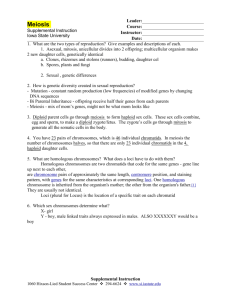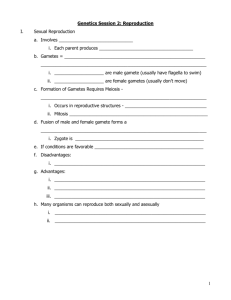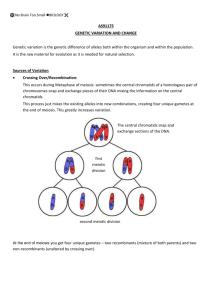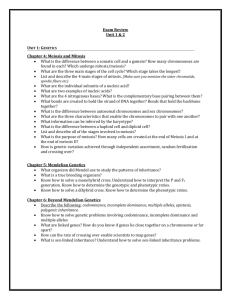Genetics I: Meiosis and Mutations
advertisement
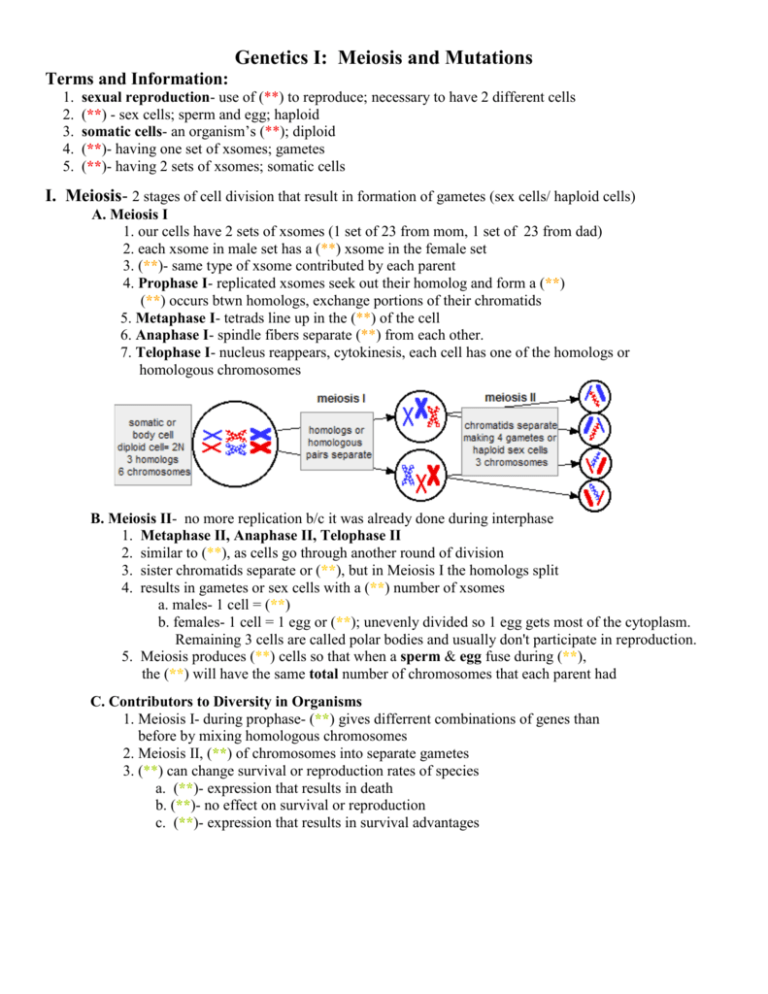
Genetics I: Meiosis and Mutations Terms and Information: 1. 2. 3. 4. 5. sexual reproduction- use of (**) to reproduce; necessary to have 2 different cells (**) - sex cells; sperm and egg; haploid somatic cells- an organism’s (**); diploid (**)- having one set of xsomes; gametes (**)- having 2 sets of xsomes; somatic cells I. Meiosis- 2 stages of cell division that result in formation of gametes (sex cells/ haploid cells) A. Meiosis I 1. our cells have 2 sets of xsomes (1 set of 23 from mom, 1 set of 23 from dad) 2. each xsome in male set has a (**) xsome in the female set 3. (**)- same type of xsome contributed by each parent 4. Prophase I- replicated xsomes seek out their homolog and form a (**) (**) occurs btwn homologs, exchange portions of their chromatids 5. Metaphase I- tetrads line up in the (**) of the cell 6. Anaphase I- spindle fibers separate (**) from each other. 7. Telophase I- nucleus reappears, cytokinesis, each cell has one of the homologs or homologous chromosomes B. Meiosis II- no more replication b/c it was already done during interphase 1. Metaphase II, Anaphase II, Telophase II 2. similar to (**), as cells go through another round of division 3. sister chromatids separate or (**), but in Meiosis I the homologs split 4. results in gametes or sex cells with a (**) number of xsomes a. males- 1 cell = (**) b. females- 1 cell = 1 egg or (**); unevenly divided so 1 egg gets most of the cytoplasm. Remaining 3 cells are called polar bodies and usually don't participate in reproduction. 5. Meiosis produces (**) cells so that when a sperm & egg fuse during (**), the (**) will have the same total number of chromosomes that each parent had C. Contributors to Diversity in Organisms 1. Meiosis I- during prophase- (**) gives differrent combinations of genes than before by mixing homologous chromosomes 2. Meiosis II, (**) of chromosomes into separate gametes 3. (**) can change survival or reproduction rates of species a. (**)- expression that results in death b. (**)- no effect on survival or reproduction c. (**)- expression that results in survival advantages II. Genes and types of Mutations A. Genes 1. is a length of DNA located on (**). 2. there are (**) of genes on each xsome that encode information 3. gene expression is caused by controlling the sequence of a.a. in a (**) 4. genes are factors that control traits 5. (**)- genes on the same xsome B. Gene Mutations 1. caused by a change in (**) sequence of a protein 2. impacts of mutations (**) 3. gene mutation- change to 1 or several bases in nucleotide sequence of DNA a. bases added, deleted, replaced (changed) i. (**)- single base or base pair change (Sickle Cell) ii. (**)- 1 missing/added base, transcribed by mRNA b. mutations are rare b/c cells have proofreading and correction (**) c. these chance events (mutations) are caused by (**) ex. viruses, UV light, chemicals like mustard gas Deletion and addition Mutations animation C. Chromosomal Mutations- change in structure or number of chromosomes Detected by KARYOTYPING which matches homologous chromosomes in a diploid cell by: 1. size of chromosome 2. length of chromatid arms 3. centromere location Samples are collected by doing either an amniocentesis or chorionic villus sampling. Karyotype of a normal 1 fig 1. 2 3 female 4 5 Karyotype of a normal 1 2 3 male 4 5 6 7 8 9 10 6 7 8 9 10 11 12 13 14 15 11 12 13 14 15 16 17 18 19 20 16 17 18 19 20 21 22 23 21 22 23 fig 2. C. Chromosomal Mutations Continued- change in structure or number of xsome Theoretically Normal Chromos ome Structure note : ea ch letter or seg men t o n a chro m oso me rep resen ts a gen e in pro per lo cus A B C D E F and G H I J K fig 3. 1. Structure (colored letters come from the fig 3. above) a. (**) - loss of part of a xsome AC DEF b. (**) - segment is repeated ABBC DEF c. (**) - orientation is reverse of normal AED CBF (twisting) d. (**) - parts are broken off and added to another xsome ex. ABC DEF and GH IJK is changed to ABC JK and GH IDEF 2. Nondisjunction deals with whole xsomes or sets of xsomes "not coming apart" a. with one xsome- during meiosis cell gets both copies of a xsome and the other cell is missing one xsome because sister chromatids didn’t separate i. (**)- is the condition of having only 1 chromosome of a homologous pair, Turner Syndrome= monosomy of 23rd pair ii. (**)-is the condition of having 3 xsomes of a homologous pair, Down Syndrome (21st pair), Klinefelter Synd (23rd pair) b. (**)- extra sets of xsomes in the same cell *animals die, but plants get larger i. (**) (1N) - 1 set of xsomes, human gamete has 23 xsomes ii. (**) (2N) - 2 sets of xsomes, human body cells have 46 xsomes iii. (**) (3N) - three sets of xsomes iv. (**) (4N) - four sets of xsomes Using your skills, label the following karyotypes with the disorder (if any) and gender: (**) (**) 1 2 3 4 5 1 3 4 5 6 7 8 9 10 6 7 8 9 10 11 12 13 14 15 11 12 13 14 15 16 17 18 19 20 16 17 18 19 20 21 22 23 21 22 23 2 3 fig 4. fig 5. (**) (**) 1 2 3 4 5 1 4 5 6 7 8 9 10 6 7 8 9 10 11 12 13 14 15 11 12 13 14 15 16 17 18 19 20 16 17 18 19 20 21 22 23 21 22 23 fig 6. fig 7. (**) 1 fig 8. 2 (**) 2 3 4 5 1 2 3 4 5 6 7 8 9 10 6 7 8 9 10 11 12 13 14 15 11 12 13 14 15 16 17 18 19 20 16 17 18 19 20 21 22 23 21 22 23 fig 9.
